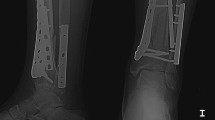Abstract
Extensor hallucis capsularis (EHC) is an accessory tendon located medially to extensor halluces longus (EHL) tendon. Most EHC is known to originate as a tendinous slip of the EHL tendon, although it may be splitted from the tibialis anterior (TA) tendon or the extensor halluces brevis (EHB) tendon. During routine dissection of a 49-year-old male cadaver, independent muscle bellies of EHC were discovered bilaterally. The EHL muscle arose from the middle anteromedial aspect of fibula, lateral to the origin of TA muscle and medial to extensor digitorum longus (EDL) muscle. An additional muscle bellies were separated from EHL muscle at the point of 6 cm away from EHL origin in the right leg, and 3 cm away in the left. They coursed downward as EHC to reach the first metatarsophalangeal joint capsule. This muscle, unlike the variations identified to date, is considered to extend to EHC, and the name “extensor hallucis capsularis muscle” is offered. This kind of variation may be important for investigating the development of deformity at the first metatarsophalangeal joint, such as hallux valgus.


Similar content being viewed by others
References
Al-saggaf S (2003) Variations in the insertion of the extensor hallucis longus muscle. Folia Morphol (Warsz) 62(2):147–155
Bergman RA AA, Miyauchi R Illustrated encyclopedia of human anatomic variation: opus I: muscular system: alphabetical listing of muscles: extensor hallucis longus. https://www.anatomyatlases.org/AnatomicVariants/MuscularSystem/Text/E/23Extensor.shtml. Accessed 12 Sept 2020
Bibbo C, Arangio G, Patel DV (2004) The accessory extensor tendon of the first metatarsophalangeal joint. Foot Ankle Int 25(6):387–390
Boyd N, Brock H, Meier A, Miller R, Mlady G, Firoozbakhsh K (2006) Extensor hallucis capsularis: frequency and identification on MRI. Foot Ankle Int 27(3):181–184
Egea JM, Cabeza L, Ortiz R, Rama AR, Melguizo C, Prados J (2019) Double origin of the extensor hallucis longus muscle: a case report. Surg Radiol Anat 41(12):1421–1423
Gruber W (1875) Über die varietäten des Musculus extensor hallucis longus. Arch Anat Physiol Wissen Med 1875:565–589
Gruber W (1876) Ein neuer Fall von Musculus extensor hallucis longus tricaudatus. Arch Anat Physiol Wissen Med 1876:750–752
Hill RV, Gerges L (2008) Unusual accessory tendon connecting the hallucal extensors. Anat Sci Int 83(4):298–300
Jarusriwanna A, Thamphongsri K, Chuckpaiwong B (2016) Frequency and characteristics of extensor hallucis capsularis: a cadaveric study. J Med Assoc Thai 99(11):1215–1219
DA Moore KL (1999) Clinically oriented anatomy, 4th edn. Lippincott Williams and Wilkins, New York
Natsis K, Konstantinidis GA, Symeonidis PD, Totlis T, Anastasopoulos N, Stavrou P (2017) The accessory tendon of extensor hallucis longus muscle and its correlation to hallux valgus deformity: a cadaveric study. Surg Radiol Anat 39(12):1343–1347
Olewnik L, Podgorski M, Polguj M, Ruzik K, Topol M (2019) A cadaveric study of the morphology of the extensor hallucis longus: a proposal for a new classification. BMC Musculoskelet Disord 20(1):310
Tezer M, Cicekcibasi AE (2012) A variation of the extensor hallucis longus muscle (accessory extensor digiti secundus muscle). Anat Sci Int 87(2):111–114
Williams PLBL, Berry MM et al (1995) Gray’s anatomy: the anatomical basis of medicine and surgery, 38th edn. Churchill Livingstone, Edinburgh
Wood J (1867) Variations in human myology observed during the winter session of 1866–1867 at King’s College, London. Proc R Soc Lond 15:518–546
Zdilla MJ, Paulet JE, Lear JJ, Addie KM, Lambert HW (2018) A review of extensor hallucis longus variants featuring a novel extensor primi internodii hallucis muscle merging with extensor hallucis brevis. J Foot Ankle Surg 57(6):1218–1220
Acknowledgements
We thank prof. Seung-Ho Han for contributing to the dissection of the cadavers.
Author information
Authors and Affiliations
Contributions
J.H.P and Y.J.C contributed to the conception of the study. Y.J.C, K.R.P., D.K., H.W.K. and M.L. contributed to the investigation of cadavers. Y.J.C and J.C. wrote the original manuscript. J.H.P. and J.C reviewed and edited the manuscripts.
Corresponding author
Ethics declarations
Conflict of interest
The authors declare that there are no conflicts of interest related to this case report.
Additional information
Publisher's Note
Springer Nature remains neutral with regard to jurisdictional claims in published maps and institutional affiliations.
Rights and permissions
About this article
Cite this article
Park, JH., Choi, YJ., Park, KR. et al. Independent muscle of extensor hallucis capsularis: a cadaveric case report. Surg Radiol Anat 43, 1041–1044 (2021). https://doi.org/10.1007/s00276-020-02592-7
Received:
Accepted:
Published:
Issue Date:
DOI: https://doi.org/10.1007/s00276-020-02592-7




